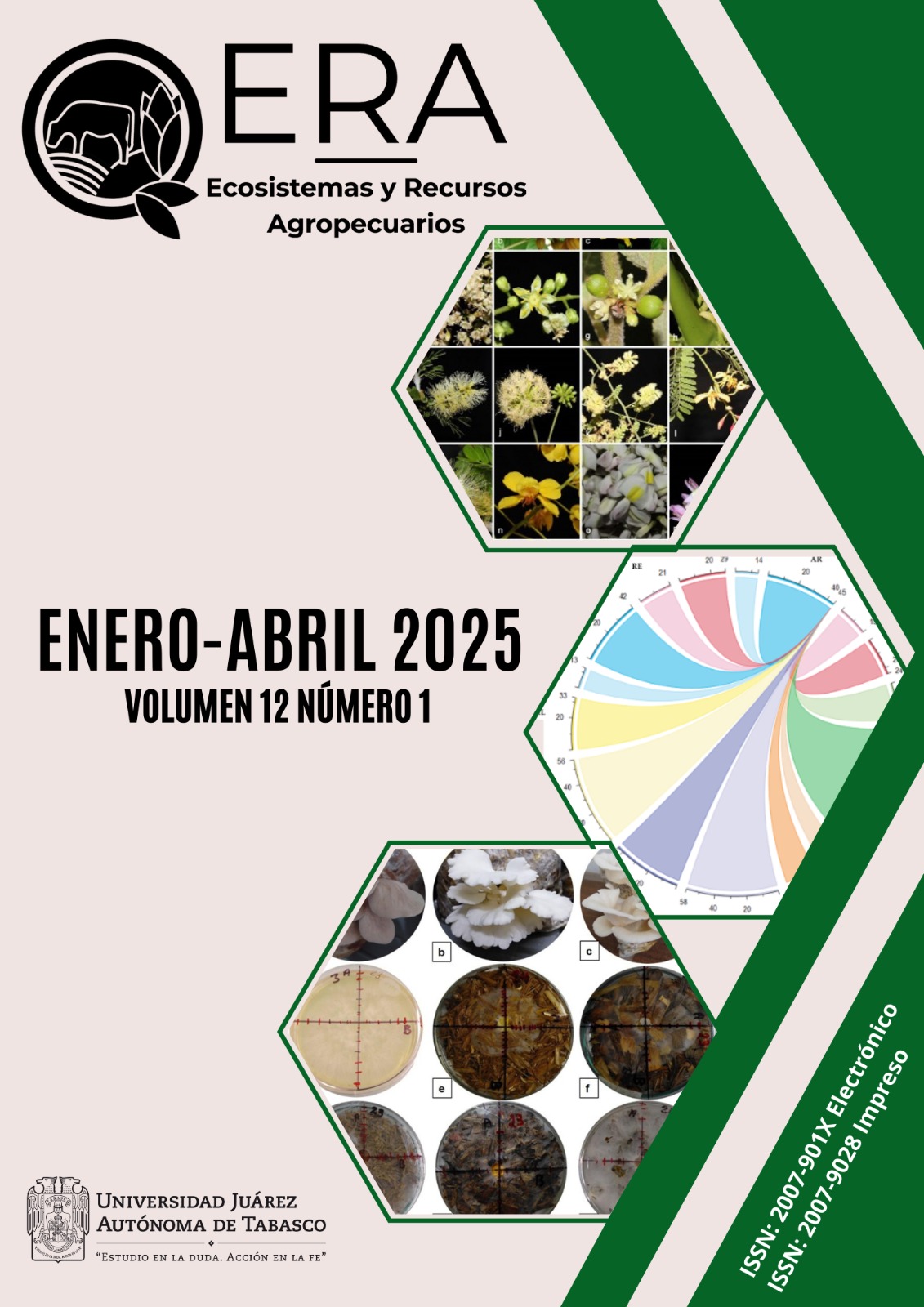Allelopathic effect of Capsicum chinense, Dianthus caryophyllus, and Sorghum bicolor on seeds
DOI:
https://doi.org/10.19136/era.a12n1.4248Keywords:
Natural extracts, Weed control, Bioactive compounds, Germination inhibitionAbstract
Weeds represent a threat to agricultural production, causing significant losses in various crops. Chemically synthesized herbicides have been widely used for their control; however, their use entails environmental and resistance problems that pose important challenges. Aware of this problem, we have sought to develop more sustainable alternatives within the framework of sustainable agriculture. Plant extracts offer promising characteristics, such as their degradability, low cost, and effectiveness. In this context, the main objective of this work is to develop an alternative based on plant extracts from Capsicum chinense L., Dianthus caryophyllus L., and Sorghum bicolor L. With HPLC/MS and GC-MS/MS analysis, we were able to find antioxidant compounds (DPPH), measure total phenols, and find volatile compounds. Additionally, we conducted germination inhibition tests on model seeds of Phaseolus vulgaris L. and Avena sativa L., utilizing the various extracts under evaluation. The results revealed the presence of various families of compounds, which contributed to the allelopathic activity of the extracts. The model seeds showed inhibition of germination, indicating a potential pre-emergence herbicidal effect of the selected treatments. The plant extracts analyzed exhibit a wide variety of bioactive and significant herbicidal activities. Therefore, we postulate its use as a viable and sustainable alternative for controlling weed germination in agricultural systems, potentially promoting more environmentally friendly agricultural practices.
Downloads
References
Al-Snafi AE (2017) Chemical contents and medical importance of Dianthus caryophyllus- A review. IOSR Journal of Pharmacy 07(03): 61-71. https://doi.org/10.9790/3013-0703016171
Balbi V, Devoto A (2008) Jasmonate signalling network in Arabidopsis thaliana: Crucial regulatory nodes and new physiological scenarios. New Phytologist 177(2): 301-318. https://doi.org/10.1111/j.1469-8137.2007.02292.x
Bastidas DA, Guerrero JA, Wyckhuys K (2013) Residuos de plaguicidas en cultivos de pasifloras en regiones de alta producción en Colombia. Revista Colombiana de Química 42(2): 39-47.
Bo AB, Kim JD, Kim YS, Sin HT, Kim HJ, Khaitov B, Choi JS (2019) Isolation, identification and characterization of Streptomyces metabolites as a potential bioherbicide. PloS One 14(9): e0222933. https://doi.org/10.1371/journal.pone.0222933
Castillo F, Hernández D, Gallegos G, Mendez M, Rodríguez R, Reyes A, Aguilar CN (2010) In vitro antifungal activity of plant extracts obtained with alternative organic solvents against Rhizoctonia solani Kühn. Industrial Crops and Products 32(3): 324-328. https://doi.org/10.1016/j.indcrop.2010.05.013
Cerda-Cejudo ND, Buenrostro-Figueroa JJ, Sepúlveda L, Torres-Leon C, Chávez-González ML, Ascacio-Valdés JA, Aguilar CN (2022) Recovery of ellagic acid from mexican rambutan peel by solid-state fermentation-assisted extraction. Food and Bioproducts Processing 134: 86-94. https://doi.org/10.1016/j.fbp.2022.05.001
Cordeau S, Triolet M, Wayman S, Steinberg C, Guillemin JP (2016) Bioherbicides: Dead in the water? A review of the existing products for integrated weed management. Crop Protection 87: 44-49. https://doi.org/10.1016/j.cropro.2016.04.016
Ding J, Liu J, Zhang Z, Guo J, Cheng M, Wan Y, Xie SS (2020). Design, synthesis and biological evaluation of coumarin-based N-hydroxycinnamamide derivatives as novel histone deacetylase inhibitors with anticancer activities. Bioorganic Chemistry 101: 104023. https://doi.org/10.1016/j.bioorg.2020.104023
De-Mastro G, El-Mahdi J, Ruta C (2021). Bioherbicidal potential of the essential oils from Mediterranean Lamiaceae for weed control in organic farming. Plants 10(4): 818. https://doi.org/10.3390/plants10040818
Dos Santos FE, Carvalho MSS, Silveira GL, Correa FF, Cardoso MDG, Andrade-Vieira LF, Vilela LR (2019) Phytotoxicity and cytogenotoxicity of hydroalcoholic extracts from Solanum muricatum Ait. and Solanum betaceum Cav. (Solanaceae) in the plant model Lactuca sativa. Environmental Science and Pollution Research 26: 27558-27568.https://doi.org/10.1007/s11356-017-1015-x
Espinosa-García FJ, Villaseñor JL (2017) Biodiversity, distribution, ecology and management of non-native weeds in Mexico: A review. Revista Mexicana de Biodiversidad 88: 76-96. https://doi.org/10.1016/j.rmb.2017.10.010
Fisher AJ (2013) Resistencia a herbicidas: Mecanismos y mitigación. Revista Especial de Malezas 29: 13-19.
Fu Y, Zhang SQ, Liu YX, Wang JY, Gao S, Zhao LX, Ye F (2019) Design, synthesis, SAR and molecular docking of novel green niacin-triketone HPPD inhibitor. Industrial Crops and Products 37: 566-575. https://doi.org/10.1016/j.indcrop.2019.05.070
González XA, Ronquillo-Cedillo I, Ávila-Nájera DM, Rodríguez-Hernández C, Pedraza-Mandujano J, Martínez-Jiménez DL (2022) Riesgos a la salud por el uso de herbicidas. Producción Agropecuaria y Desarrollo Sostenible 10(1): 23-33. https://doi.org/10.5377/payds.v10i1.13341
Guevara-González J, Narváez-Flies C, Marín-Navarrete A, Gutiérrez-López J, Troncoso-Troncoso C (2019) Bioherbicida a partir de extracto fenólico obtenido de residuos de almazaras. Scientia Agropecuaria 10(4): 497-503. http://dx.doi.org/10.17268/sci.agropecu.2019.04.06
Hoagland RE (2001) Microbial allelochemicals and pathogens as bioherbicidal agents. Weed Technology 15(4): 835-857. https://doi.org/10.1614/0890-037X(2001)015[0835:MAAPAB]2.0.CO;2
Islam AM, Kato-Noguchi H (2014) Phytotoxic activity of Ocimum tenuiflorum extracts on germination and seedling growth of different plant species. The Scientific World Journal 2014(1): 676242. https://doi.org/10.1155/2014/676242
Kothari SL, Joshi A, Kachhwaha S, Ochoa-Alejo N (2010) Chilli peppers a review on tissue culture and transgenesis. Biotechnology Advances 28(1): 35-48. https://doi.org/10.1016/j.biotechadv.2009.08.005
Liu X, Tian F, Tian Y, Wu Y, Dong F, Xu J, Zheng Y (2016) Isolation and identification of potential allelochemicals from aerial parts of Avena fatua L. and their allelopathic effect on wheat. Journal of Agricultural and Food Chemistry 64(18): 3492-3500. https://doi.org/10.1021/acs.jafc.5b05498
Lo CM, Han J, Wong ES (2020) Chemistry in aromatherapy–extraction and analysis of essential oils from plants of Chamomilla recutita, Cymbopogon nardus, Jasminum officinale and Pelargonium graveolens. Biomedical and Pharmacology Journal 13(03): 1339-1350. https://dx.doi.org/10.13005/bpj/2003
Loake G, Grant M (2007) Salicylic acid in plant defense the players and protagonists. Current Opinion in Plant Biology 10(5): 466-472. https://doi.org/10.1016/j.pbi.2007.08.008
Martínez-Ávila GC, Aguilera-Carbó AF, Rodríguez-Herrera R, Aguilar CN (2012) Fungal enhancement of the antioxidant properties of grape waste. Annals of Microbiology 62(3): 923-930. https://doi.org/10.1007/s13213-011-0329-z
Montull JM, Torra J (2023) Herbicide resistance is increasing in Spain: Concomitant management and prevention. Plants 12(3): 469. https://doi.org/10.3390/plants12030469
Morra MJ, Popova IE, Boydston RA (2018) Bioherbicidal activity of Sinapis alba seed meal extracts. Industrial Crops and Products 115: 174-181. https://doi.org/10.1016/j.indcrop.2018.02.027
Nazemi AH, Asadi GA, Ghorbani R (2018) Allelopathic potential of lavender’s Extract and coumarin applied as pre-plant incorporated into soil under agronomic conditions. Planta Daninha 36: e018160777. https://doi.org/10.1590/S0100-83582018360100069
Nielsen SS (2003) Food analysis laboratory manual. 3 edición. Kluwer Academic/Plenum Publishers, New York, NY, USA. 557p.
Palau H, Senesi S, Mogni L, Ordoñez I (2015) Impacto económico macro y micro de malezas resistentes en el agro argentino. ADAMAFAUBA 43(1): 66-68.
Qiao L, Hao S (2018) Novel trifluoromethylcoumarinyl urea derivatives: Synthesis, characterization, fluorescence, and bioactivity. Molecules 23(3): 600 https://doi.org/10.3390/molecules23030600
Ratnayaka HH, Molin WT, Sterling TM (2003) Physiological and antioxidant responses of cotton and spurred anoda under interference and mild drought. Journal of Experimental Botany 54(391): 2293-2305. https://doi.org/10.1093/jxb/erg251
Razavi SM (2011) Plant coumarins as allelopathic agents. International Journal of Biological Chemistry 5(1): 86-90.
Reyes-Escogido ML, Gonzalez-Mondragon EG, Vazquez-Tzompantzi E (2011) Chemical and pharmacological aspects of capsaicin. Molecules 16(2): 1253-1270. https://doi.org/10.3390/molecules16021253
Roberts J, Florentine S, Fernando WD, Tennakoon KU (2022) Achievements, developments and future challenges in the field of bioherbicides for weed control: A global review. Plants 11(17): 2242. https://doi.org/10.3390/plants11172242
Shajib MTI, Pedersen HA, Mortensen AG, Kudsk P, Fomsgaard IS (2012) Phytotoxic effect, uptake, and transformation of biochanin A in selected weed species. Journal of Agricultural and Food Chemistry 60(43): 10715-10722. https://doi.org/10.1021/jf3023589
Sora GTS, Haminiuk CWI, da Silva MV, Zielinski AAF, Gonçalves GA, Bracht A, Peralta RM (2015) A comparative study of the capsaicinoid and phenolic contents and In vitro antioxidant activities of the peppers of the genus Capsicum: An application of chemometrics. Journal of Food Science and Technology 52: 8086-8094.
Steel RG, Torrie JH (1981) Principles and procedures of statistics, a biometrical approach. McGraw-Hill Kogakusha, Ltd. Japan. 633p.
Tucuch-Pérez MA, Mendo-González EI, Ledezma-Pérez A, Iliná A, Hernández-Castillo FD, Barrera-Martinez CL, Arredondo-Valdés R (2023) The herbicidal activity of nano-and microencapsulated plant extracts on the development of the indicator plants Sorghum bicolor and Phaseolus vulgaris and their potential for weed control. Agriculture 13(11): 2041. https://doi.org/10.3390/agriculture13112041
Vlot AC, Dempsey DMA, Klessig DF (2009) Salicylic acid, a multifaceted hormone to combat disease. Annual Review of Phytopathology 47: 177-206. https://doi.org/10.1146/annurev.phyto.050908.135202
Waliszewski SM, Szymczynski GA, Serafin Z, Infanzón RM, Siliceo J (2002) Ésteres de ftalatos-factor orquidotóxico. Revista Internacional de Contaminación Ambiental 18(2): 91-105.
Zenil-Lugo N, Colinas-León MT, Bautista-Bañuelos C, Vázquez-Rojas TR, Lozoya-Saldaña H, Martínez-Damián MT (2014) Fenoles totales y capacidad antioxidante estimada con los ensayos DPPH/ABTS en rosas en soluciones preservantes. Revista Mexicana de Ciencias Agrícolas 5(6): 1029-1039.
Downloads
Published
Issue
Section
License
Copyright (c) 2025 Ecosistemas y Recursos Agropecuarios

This work is licensed under a Creative Commons Attribution-NonCommercial-NoDerivatives 4.0 International License.
Aviso de copyright
Los autores que se envían a esta revista aceptan los siguientes términos:
una. Los autores conservan los derechos de autor y garantizan a la revista el derecho a ser la primera publicación del trabajo con una licencia de atribución de Creative Commons que permite a otros compartir el trabajo con un reconocimiento de la autoría del trabajo y la publicación inicial en esta revista.
B. Los autores pueden establecer acuerdos complementarios separados para la distribución no exclusiva de la versión del trabajo publicado en la revista (por ejemplo, en un repositorio institucional o publicarlo en un libro), con un reconocimiento de su publicación inicial en esta revista.
C. Se permite y se anima a los autores a difundir su trabajo electrónicamente (por ejemplo, en repositorios institucionales o en su propio sitio web) antes y durante el proceso de envío, ya que puede conducir a intercambios productivos, así como a una cita más temprana y más extensa del trabajo publicado. (Consulte El efecto del acceso abierto).


